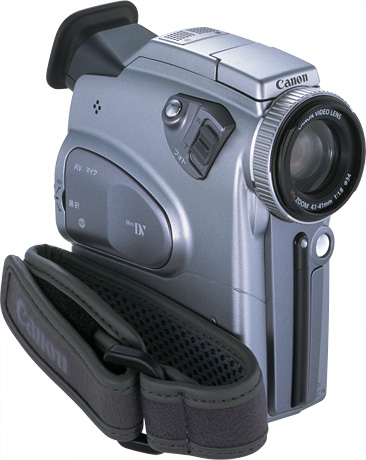- Outline
- Specifications
| Marketed | September 2002 |
Unlike electronic image stabilizing methods, the new IXY DV M’s Optical Image Stabilizer corrects for camera shake without causing any degradation of image quality, making possible smooth, steady, blur-free images when taking still shots, as well as when shooting movies. As a result, the IXY DV M realizes high-quality 1.23-million-pixel blur-free still images throughout the entire zoom range.
Featuring a sleek vertical design, the IXY DV M is equipped with a newly developed compact video lens with 10x optical zoom.
Furthermore, Canon’s proprietary MACS (Multi Architecture Camera System) camera-signal-processing LSI (large-scale integrated circuit) processes movie and still signals separately, contributing to natural color reproduction. The LSI automatically assumes that tape-recorded images will be displayed on TV monitors and card-recorded images printed out, optimizing color processing accordingly to ensure vivid high-quality color reproduction in either mode.
Canon’s new camcorder also supports Camera Direct printing of still shots captured on memory cards. Requiring only a single proprietary cable connection between the camcorder and Canon Card Photo Printers CP-10 and CP-100, or Ink Jet Printers BJ 895PD and BJ 535 PD (all sold separately), Camera Direct eliminates the need for a PC in the print process by enabling users to control print settings directly from the camcorder’s LCD screen.
Further enhancing still photography performance, the IXY DV M also supports the Exif Print (Exif 2.2) standard defined and controlled by JEITA (Japan Electronics and Information Technologies Industries Association).
The IXY DV M’s Accessory Kit AK-550 (sold separately) includes Canon’s DV Messenger communication software, supporting visual and audio communication as a “TV-phone” when the camcorder is connected to the Internet*. DV Messenger software enables users to remotely control from their PC the functions of the Canon camcorder** being used by the person with whom they are communicating. In addition, it allows the users to exchange digital still-image files and view movies recorded on each other’s camcorder.
*Requires Microsoft Windows Messenger, which can be downloaded free of charge from Microsoft, and presumes a PC environment which meets Microsoft’s specifications
**Remote control only possible for Canon digital video camcorders sold from March 1999 and using DV Messenger
| Power supply (rated) | 7.4 V DC (Battery) 9.5 V DC (DC IN) |
| Power consumption | 3.9 W (using viewfinder), 4.8 W (using LCD screen) |
| Television system | EIA standard (525 lines, 60 fields) NTSC color signal |
| Video recording system | 2 rotary heads, helical scanning system DV system (Consumer digital VCR SD/SDL system) Digital component recording |
| Audio recording system | PCM digital sound: 16-bit (48 kHz/2 ch.) 12-bit (32 kHz/4 ch.) |
| Image sensor | 1/4″ CCD (charge coupled device) approx. 1.33 million pixels (approx. 1.23 million pixels for still images recorded onto memory card and 690,000 pixels for movie and still images recorded onto tape) |
| Tape format | Videocassettes bearing the MiniDV mark |
| Tape speed | SP: 3/4 ips (18.81 mm/sec.) LP: 1/2 ips (12.56 mm/sec.) |
| Maximum recording time (with an 80-min. cassette) | SP: 80 min. LP: 120 min. |
| Fast forward/rewind time | 2 min. 20 sec. (with a 60-min. cassette) |
| Lens | f/1.8 – 2.1, 10x power zoom, 4.1 – 41.0 mm (39.5 – 395 mm in CARD CAMERA mode) |
| Focusing system | TTL autofocus, manual focusing possible |
| Minimum focusing distance | 1 m (3 ft. 3 3/8 in.) 1 cm (3/8 in.) on maximum wide angle |
| Maximum shutter speed | 1/8,000 sec. (1/500 when using memory card) |
| Minimum illumination | 0.5 lux using the Night program during tape recording |
| Recommended illumination | More than 100 lx |
| Filter diameter | 34 mm |
| Viewfinder | 0.5″, color LCD (approx. 113,000 pixels) |
| LCD screen: | 2.5″ measured diagonally (approx. 200,000 pixels) |
| Microphone | Stereo electret condenser microphone |
| Flash | Built-in, Auto pop-up flash |
| Recording Media | MultiMediaCard, SD Memory Card |
| Number of recording pixels | 1280 x 960 pixels, 640 x 480 pixels; Movie: 320 x 240 pixels (approx. 10 secs)*, 160 x 120 pixels (approx. 30 sec.)* *The figures in brackets represent the maximum length of one movie clip. |
| Image format | Design rule for Camera Format System (DCF), Digital Print Order Format (DPOF)-compliant (only images, marked for printing) |
| File format | JPEG (compression mode: Fine/Standard) |
| Estimated MultiMediaCard MMC-8M capacities (approx) | 1280 x 960: 6 Superfine images, Fine 10 images, Standard 18 images, 640 x 480:Superfine 34 images, Fine 50 images, Standard 84 images |
| DV terminal | Special 4-pin connector (based on IEEE 1394) |
| Video terminal | 1 Vp-p/75 ohms unbalanced |
| S-video terminal | 1 Vp-p (Y signal), 0.286 Vp-p (C signal) |
| Audio terminal | Input level: -10 dBV/40 kohm, unbalanced Output level: -10 dBV, less than 3 kohm, unbalanced |
| Operating temperature range | 32 – 104° F (0 – 40° C) |
| Dimensions | 60 x 119 x 118 mm (2 3/8 x 4 5/8 x 4 5/8 in.) |
| Weight | 530 g (1 lb. 2 3/4 oz.) |


